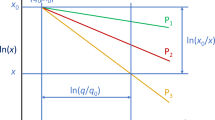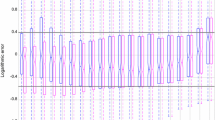Conclusions
-
1.
It is shown that a hyperbolic relation between the yield of oversize pieces and the specific explosive consumption, VH=VH(q), fails over a wide range of consumptions to correspond with data on the structure of fissured virign rocks, and dos not agree with the practice of blasting in quarries.
-
2.
Starting from A. F. Belyaev’s postulate on the fragmentation of large volumes of rock, a theoretical relation is derived for VH in tems of q, which is plotted as a straight line. The accuracy of this law is confirmed experimentally for the conditions of quarries; it gives a sound basis for calculations of the parameters of blasting work for a given fragmentation.
-
3.
The principle of uniform distribution of explosive in the virgin rock is formulated.
-
4.
In studying the relation VH=VH(q) and other topics, in rock blasting, underground work must be treated separately from open-cutwork.
Similar content being viewed by others
Literature Cited
V. L. Terent’ev, Investigation of the relation between the fragment size of blasted ore and the blasting parameters. Topics in Rock Fragmenation by Blasting [in Russian], Moscow, Izd. AN SSSR (1958).
D. M. Bronnikov and N. F. Zamesov, Investigation of the laws governing the fragmentation of ore broken down by blasting [in Russian], Moscow, Izd. A. A. Skochinsk IGD (1963).
L. I. Baron and N. F. Andrianov, Investigation of the efficiency of fragmentation of rocks by blasting with Igdanite in quarries. Vzryvnoe delo, No. 53/10 [in Russian], Moscow, Gosgortekhizdat (1963).
G. P. Demidyuk, New Methods in Blasting. Summaries of reports of scientific conference on blasting, No. 1 [in Russian], Moscow, Izd. IGD im. A. A. Skochinskogo (1965).
L. V. Dubnov, The contemporary choice of explosives and their development for mining. Summaries of reports to scientific conference on blasting [in Russian], No. 1, Moscow, Izd. A. A. Skochinskogo, IGD (1965).
A. F. Belyaev and L. I. Azbukina, Influence of the properties of explosive charges on the fragmentation of blocks of cement solution. Vzryvnye rabory, No. IV [in Russian], Moscow, Nedra (1965).
S. A. Davydov and V. K. Rubtsov, Multirow Blasting [in Russian], Moscow, Nedra (1965).
K. K. Andreev and A. F. Belyaev, The Theory of Explosives [in Russian], Moscow, Oborongiz (1960).
V. K. Rubtsov, Method of determining the relative work capacities of explosives in rocks. Vzryvnoe delo, No. 57/14 [in Russian], Moscow, Nedra (1965).
V. K. Rubtsov, On the mechanism of fragmentation of rock by blasting. Tr. TsNIGRI, No. 62 [in Russian], Moscow, Izd. VINITI (1964).
Additional information
TsNIGRI, Moscow. Translated from Fiziko-Tekhnicheskie Problemy Razrabotki Poleznykh Iskopaemykh, No. 1, pp. 53–59, January–February, 1967.
Rights and permissions
About this article
Cite this article
Rubtsov, V.K. Yield of large rock fragments versus specific explosive consumption in blasting. Soviet Mining Science 3, 40–44 (1967). https://doi.org/10.1007/BF02497065
Received:
Issue Date:
DOI: https://doi.org/10.1007/BF02497065




